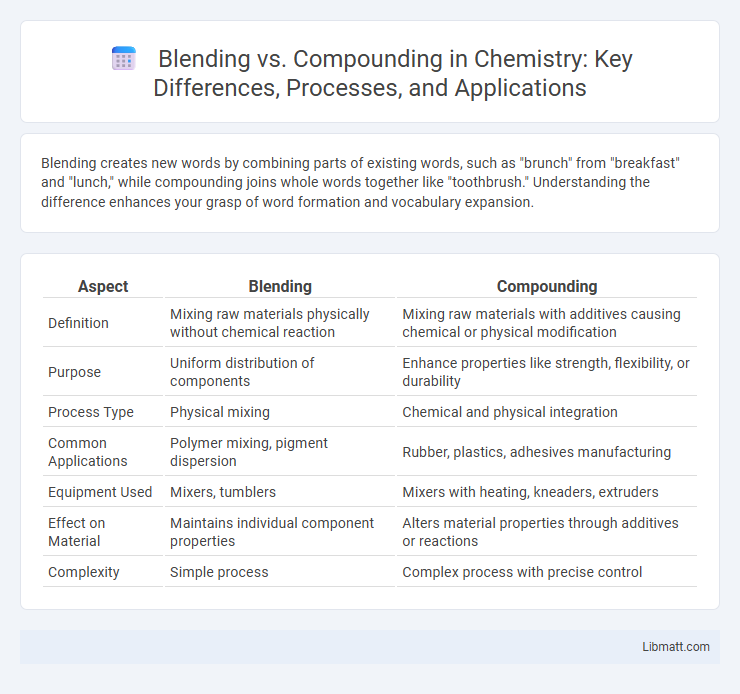Blending creates new words by combining parts of existing words, such as "brunch" from "breakfast" and "lunch," while compounding joins whole words together like "toothbrush." Understanding the difference enhances your grasp of word formation and vocabulary expansion.
Table of Comparison
| Aspect | Blending | Compounding |
|---|---|---|
| Definition | Mixing raw materials physically without chemical reaction | Mixing raw materials with additives causing chemical or physical modification |
| Purpose | Uniform distribution of components | Enhance properties like strength, flexibility, or durability |
| Process Type | Physical mixing | Chemical and physical integration |
| Common Applications | Polymer mixing, pigment dispersion | Rubber, plastics, adhesives manufacturing |
| Equipment Used | Mixers, tumblers | Mixers with heating, kneaders, extruders |
| Effect on Material | Maintains individual component properties | Alters material properties through additives or reactions |
| Complexity | Simple process | Complex process with precise control |
Introduction to Blending and Compounding
Blending and compounding are two common word formation processes in linguistics that combine roots or morphemes to create new words. Blending typically involves merging parts of two words, such as "brunch" from "breakfast" and "lunch," while compounding joins whole words like "notebook" from "note" and "book." Understanding these processes helps you expand vocabulary and grasp how language evolves through morphological patterns.
Definitions: What is Blending?
Blending is a linguistic process that creates new words by merging parts of two or more existing words, such as "brunch" from "breakfast" and "lunch." This technique often combines the beginning of one word with the end of another to form a concise, meaningful term. Blends are commonly used in everyday language to introduce innovative or colloquial expressions efficiently.
Definitions: What is Compounding?
Compounding is a morphological process in linguistics where two or more words are combined to create a new word with a distinct meaning, such as "toothbrush" or "notebook." Unlike blending, which merges parts of words, compounding connects entire words to form a compound noun, verb, or adjective. Understanding compounding helps you recognize how complex vocabulary evolves and expands language efficiency.
Key Differences Between Blending and Compounding
Blending creates new words by merging parts of two existing words, often the beginning of one and the end of another, such as "brunch" from "breakfast" and "lunch." Compounding forms new words by combining two complete words, like "toothbrush" or "notebook," preserving their original forms. Understanding these processes helps you recognize how vocabulary evolves and expands in language.
Common Applications of Blending
Blending is widely used in brand naming, product innovation, and creative marketing to create memorable and catchy terms like "brunch" or "smog." In linguistic studies, it demonstrates how language evolves through the fusion of words for efficiency and expressiveness. Your content or communication strategies can benefit from blending by generating unique, engaging terms that resonate with target audiences.
Common Applications of Compounding
Compounding is widely used in pharmaceuticals to create customized medications tailored to individual patient needs, ensuring precise dosages and combinations that are not commercially available. In the plastics industry, compounding involves mixing polymers with additives to enhance material properties such as strength, flexibility, and resistance. You benefit from compounding's versatility when specific formulations require unique chemical blends for specialized applications in agriculture, cosmetics, or food production.
Advantages of Blending
Blending offers advantages such as creating shorter, catchier words that are easier to remember and often sound more natural in everyday language, enhancing communication efficiency. This method allows for innovative word formation by combining parts of two words, making it ideal for branding and marketing purposes. Your content benefits from the distinctive and engaging nature of blends, which can quickly capture attention and convey meaning effectively.
Advantages of Compounding
Compounding creates new words by combining two or more whole words, preserving clarity and meaning, which enhances comprehension and vocabulary retention. It allows for easy formation of precise and specific terms, especially useful in technical and scientific language. Compounded words often follow predictable patterns, making them easier to decode and learn for language users.
Factors to Consider When Choosing Between Blending and Compounding
Choosing between blending and compounding depends on factors such as the desired speed of word formation, the complexity of meaning, and contextual clarity. Blending is often preferred for creating catchy, concise words combining parts of two terms, while compounding joins whole words to maintain straightforward semantic relationships. Your choice should align with the goal of effective communication and target audience comprehension.
Conclusion: Which Method Best Fits Your Needs?
Blending creates new words by merging parts of existing ones, ideal for casual or creative language use, while compounding combines whole words to form clear, precise terms suited for technical or formal contexts. Your choice depends on the desired clarity and creativity level, with blending favoring innovation and compounding providing straightforward meaning. Assessing your audience and purpose ensures the selected method effectively communicates your message.
Blending vs compounding Infographic

 libmatt.com
libmatt.com